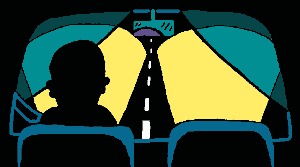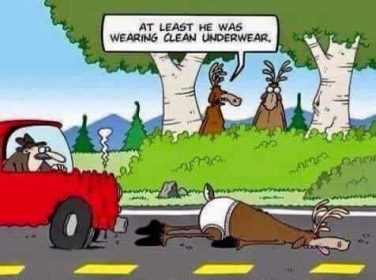 Defensive driving is a technique you can apply while operating your vehicle, to greatly lessen your chance of being involved in an accident. And it works! Defensive driving assumes first of all that you are a good driver, and won't cause an accident yourself through poor judgement, carelessness, stupidity, or simple inexperience. In simplest terms, driving defensively means assuming that:
Driving is a full-time occupation Activities such as turning your head constantly to talk to a passenger, using a cell phone, texting or otherwise not constantly watching the road ahead, will eventually cause you to have an accident. Guaranteed! It's not that you'll do something wrong; we're assuming you're a good driver, remember? Rather, when something unexpected happens ... like a patch of ice on the road, or another driver pulling out in front of you, or a moose leaping out of the ditch ... your attention will be elsewhere, and you won't react to the problem fast enough. You'll be involved in an accident that you could have avoided if you'd been more attentive. Your eyes should be on the road at all times.  Assume you may have to stop or veer suddenly Drive at the appropriate speed You'll often see people driving very fast on gravel or snowy roads. This may be perfectly safe as long as nothing unexpected happens. But try to stop suddenly or avoid a problem when going that fast on those kinds of roads, and you will have an accident, sooner or later. If you assume nothing will happen, you're not driving defensively. Something will happen, just when you least expect it to. That's why body shops do such good business! And why your insurance rates are so high! Assume the vehicle coming towards you is being driven by an idiot Lots of accidents happen because of inattentiveness on the part of one driver, or drowsiness, or by poor reflexes due to alcohol impairment. When you are approaching another vehicle coming the other way, be prepared to veer away if he moves into your lane suddenly. Look for escape routes. Check the ditch to see if you can enter it safely. Be prepared to get out of the way fast ... and do all of this every time a vehicle approaches you. This is a habit you can easily develop and eventually do unconsciously, and one day it might save your life. There are a lot of inebriated, tired, or just plain stupid drivers out there! Assume the vehicle nearing the stop sign at the cross road ahead won't stop Sometimes they don't stop. If you're not ready to react, you'll be involved in an accident you might not live through. Keep your foot over the brake pedal and be ready to react if he pulls out in front of you. Look for where you can veer off safely. Is there oncoming traffic? Do this every time! At an intersection, assume someone will be running the red light When you get the green light, don't immediately take off into the intersection. Look both ways and make sure some idiot isn't about to run the light. This kind of accident happens every day in every city in Canada. Yes, the accident won't be your fault, but that's a pretty poor consolation if you're dead. When waiting to turn left at an intersection, don't turn your wheels If you're rear-ended, you'll be pushed into oncoming traffic and a head-on collision. Keep your wheels pointing straight until it's safe to turn. My brother the cop told me this one. In city traffic, assume something unexpected could happen at any moment Keep your eye on parked cars, for pedestrians suddenly entering your lane. Watch for sudden lane changes by vehicles, and cars for appearing from driveways. Something unexpected always happens ... be ready for it. Don't tailgate at high speed Again, there's no problem if you're both good drivers. The difficulty occurs when someone up ahead has to slow down quickly and unexpectedly. If you're too close, you won't be able to react in time , regardless of how good a driver you are. This is the most common expressway accident, and it's hard to prepare for. You need to leave a full car length for every 10 mph you're driving at. But poor drivers who like to tailgate will constantly be moving into that space behind you. Readjust by taking your foot off the gas, and maintain that distance. You'll be avoiding involvement in a major accident. In heavy traffic on an expressway, use your brakes as little as possible If someone up ahead has to stop suddenly, you need to be able to react quickly. The constant flashing of brake lights as drivers moving too fast for their lane adjust their speed will tend to make you ignore brake lights ahead of you. That is, until someone is actually braking hard ... and then you'll rear-end them. Keep your distance by adjusting your speed with the accelerator; if you can't do this, you're following too closely. Remember, it's almost always the person who collides from behind who is legally at fault. When stopped at an intersection, watch your mirror You may be able to avoid being rear-ended if you keep your eye on the guy coming up behind you. If it looks like he's going too fast to stop, flash your brake lights at him, or move ahead. Use your horn Some drivers continually do stupid things because they get away with it. If someone cuts you off or does something else dangerous or stupid, let them know you saw it, with your horn. Sometimes the embarrassment of being reminded of their stupidity will improve their driving. (This is especially effective if they have a passenger to witness it) Report bad drivers Did you see someone speeding outrageously in a school zone, or witness something else that might cause a hazard to others? Get the licence number and a description of the vehicle, and either phone it in to the police, or send them a written statement. They can and will lay charges against the owner of the vehicle, based on your statement. Be especially cautious in large parking lots You'd be surprised how many accidents happen in a WalMart or Superstore parking lot. Watch for idiots driving around at highway speed, or across empty parking areas. Don't expect anyone to obey any driving rules. Use convex mirrors when driving on a multi-lane expressway Get two of those little stick-on convex mirrors, and apply them to both your side mirrors. Then practice using them until it feels natural. If they're adjusted properly, you won't have any blind spots, and will be able to change lanes at speed without turning your head. Turning your head away from what's ahead of you on an expressway, even for an instant, is dangerous.  Slow down in fog Slow down in fogRecent research has shown that even the best drivers cannot judge their speed accurately when driving in fog, and tend to drive faster than they think they are. If you're moving too fast and something unexpected occurs, you won't be able to stop in time. The moment you see it, it's too late. Slow down at night Your headlight high beams weren't designed for daytime speeds when driving at night. If you're moving too fast, you won't be able to stop in time for what appears ahead of you. This is called 'driving beyond your headlights'. It's like driving with your eyes closed ... anything that your headlights illuminate you will hit. You can't stop in time. Slow down on curves on gravel roads Whoever named these curves on gravel roads 'speed corners' made a big mistake. That name comes from the curve replacing a stop sign, so you can keep going instead of stopping before turning. It does NOT mean you can take the curve at normal speed. Inexperienced drivers think this means they can maintain the posted speed while going around the curve. YOU CAN'T. The first time they regravel the roads you will slide into the ditch, roll your vehicle, and possible die. This happens to drivers all the time because they don't slow down going around the curve ... and IT'S THEIR FAULT. Slow down. Don't ever ever ever drive after having even one drink I'm not kidding! Legally you may not be impaired, but that's just 'legally'. It's the level they've arbitrarily decided they can prosecute you for. Physically, you are impaired with just one drink! Not enough to notice, probably. Not enough even to affect your driving. But your reaction time will be slowed ... by just one drink, regardless of your age, size, weight, or drinking experience. If that 'unexpected something' decides to happen, you will react more slowly than normal. Your chance of being in an accident is increased. The purpose of defensive driving is to avoid having an accident if you can help it. Having a drink defeats the purpose entirely. If you want to stay accident-free, don't drive at all after drinking. Remember also that after consuming alcohol, there are lots of things you can do to feel more sober, like eating, getting some fresh air, or drinking coffee. But nothing except time will remove the alcohol from your system and remove the impairment. One hour alcohol-free, per drink or bottle of beer consumed, is necessary to get sober, and there is absolutely nothing you can do to change this. If you get behind the wheel when impaired, you are criminally responsible for whatever happens. Don't Text While Driving This is just a stupid thing to do, and illegal in most places. If you text while driving, eventually you will have an accident. The question is whether you will kill yourself or someone else while doing it. Superhighways If you practice defensive driving, one of the most difficult places to drive is on a superhighway ... one with 3 to 8 lanes travelling side-by-side in each direction. Having done this for many years, in all sorts of conditions, I know how dangerous it is, even if you practice defensive drivin. Some of the difficulties:
One further suggestion: if you're going to be driving on a supehighway in slushy conditions, make sure your window washer fluid resevoir is full. I found myself in a busy section of the 401 highwy in Toronto once, and my windshield wipers and washers were going almost continuously because of the mushy slush thrown up by other vehicles. Then the washer fluid ran out. I was instantly blinded as the wipers smeared the mud around instead of clearing it. I was very very lucky to have noticed an off-ramp coming up in the seconds before, and was able to steer onto it without colliding with anyone! Winter Driving Defensive diving also includes what you do to prepare for bad conditions. Here are some suggestions:
Summing everything up, if you want to avoid accidents, you need to drive defensively. This means keeping your eyes on the road at all times, anticipating bad things that could happen, and assuming every other driver is about to do something really stupid. Try it ... it works! |